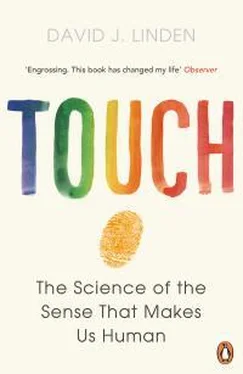CHAPTER THREE: THE ANATOMY OF A CARESS
1. If this were a proper Tarantino revenge fantasy, we’d be doing a biopsy of the pudendal nerve, the one that innervates the penis (without anesthetic, I might add). However, that one is not a pure sensory nerve, as it has motor and sympathetic axons running in it. So I’ve chosen the sural nerve to make the explanation more straightforward. Pedagogy trumps poetry, I guess.
2. A-delta fibers, being lightly myelin-wrapped and intermediate in diameter, have a range of conduction velocities in between those of A-beta fibers and C-fibers: around 10 to 70 miles per hour.
3. The C-tactile neurons and their associated axonal fibers identified in this paper are molecularly distinct from other sensory neurons because they express an enzyme called tyrosine hydroxylase. L. Li, M. Rutlin, V. E. Abraira, C. Cassidy, L. Kus, S. Gong, M. P. Jankowski, W. Luo, N. Heintz, H. R. Koerber, C. J. Woodbury, and D. D. Ginty, “The functional organization of cutaneous low-threshold mechanosensory neurons,” Cell 147 (2011): 1615–27. It is possible that there are other populations of C-tactile neurons. A different group has shown that a particular receptor called MrgprB4 defines a unique population of C-fibers that innervate hairy but not glabrous skin and thereby are potential candidates for C-tactile fibers. Unfortunately, to date, recordings from these fibers with electrodes have failed to reveal electrical activity evoked by light stroking of the hairy skin, so the role of MrgprB4-expressing C-fibers in caress detection remains unclear. Q. Liu, S. Vrontou, F. L. Rice, M. J. Zylka, X. Dong, and D. J. Anderson, “Molecular genetic visualization of a rare subset of unmyelinated sensory neurons that may detect gentle touch,” Nature Neuroscience 10 (2007): 946–48; and S. Vrontou, A. M. Wong, K. K. Rau, H. R. Koerber, and D. J. Anderson, “Genetic identification of C-fibers that detect massage-like stroking of hairy skin in vivo,” Nature 493 (2013): 669–73.
4. A. B. Sterman, H. H. Schaumburg, and A. K. Asbury, “The acute sensory neuronopathy syndrome: a distinct clinical entity,” Annals of Neurology 7 (1980): 354–58. Acute sensory neuronopathy is not heritable and is permanent. It is not typically associated with disruption of immune function. In many, but not all, cases, it has followed treatment with high doses of certain antibiotics such as penicillin or related compounds.
5. O. Sacks, “The Disembodied Lady,” in The Man Who Mistook His Wife for a Hat (London: Duckworth, 1985), 42–52.
6. H. Olausson, J. Cole, K. Rylander, F. McGlone, Y. Lamarre, B. G. Wallin, H. Kramer, J. Wessberg, M. Elam, M. C. Bushnell, and Å. Vallbo, “Functional role of unmyelinated tactile afferents in human hairy skin: sympathetic response and perceptual localization,” Experimental Brain Research 184 (2008): 135–40.
7. L. S. Löken, J. Wessberg, I. Morrison, F. McGlone, and H. Olausson, “Coding of pleasant touch by unmyelinated afferents in humans,” Nature Neuroscience 12 (2009): 547–48; and R. Ackerley, E. Eriksson, and J. Wessberg, “Ultra-late EEG potential evoked by preferential activation of unmyelinated tactile afferents in human hairy skin,” Neuroscience Letters 535 (2013): 62–66.
8. H. Olausson, Y. Lamarre, H. Backlund, C. Morin, B. G. Wallin, G. Starck, S. Ekholm, I. Strigo, K. Worsley, Å. B. Vallbo, and M. C. Bushnell, “Unmyelinated tactile afferents signal touch and project to insular cortex,” Nature Neuroscience 5 (2002): 900–904; M. Björnsdottir, L. Löken, H. Olausson, Å. Vallbo, and J. Wessberg, “Somatotopic organization of gentle touch processing in the posterior insular cortex,” Journal of Neuroscience 29 (2009): 9314–20; and I. Morrison, M. Björnsdottir, and H. Olausson, “Vicarious responses to social touch in posterior insular cortex are tuned to pleasant caressing speeds,” Journal of Neuroscience 31 (2011): 9554–62.
9. There’s some argument about the historical details here. Some people in Norrbotten believe that the pain-insensitive founder lived even earlier, perhaps before the ancestors of the affected Norrbotten families moved to Norrbotten from southern Finland in the sixteenth century.
10. The Norrbotten pain-insensitivity syndrome is called hereditary sensory and autonomic neuropathy type V, abbreviated as HSAN V. E. Einarsdottir, A. Carlsson, J. Minde, G. Toolanen, O. Svensson, G. Solders, G. Holmgren, D. Holmberg, and M. Holmberg, “A mutation in the nerve growth factor beta gene ( NGFB ) causes loss of pain perception,” Human Molecular Genetics 13 (2004): 799–805; J. Minde, G. Toolanen, T. Andersson, I. Nennesmo, I. N. Remahl, O. Svensson, and G. Solders, “Familial insensitivity to pain (HSAN V) and mutation in the NGFB gene. A neurophysiological and pathological study,” Muscle & Nerve 30 (2004): 752–60; and D. C. de Andrade, S. Baudic, N. Attal, C. L. Rodrigues, P. Caramelli, A. M. M. Lino, P. E. Marchiori, M. Okada, M. Scaff, D. Bouhassira, and M. J. Teixeira, “Beyond neuropathy in hereditary sensory and autonomic neuropathy type V: cognitive evaluation,” European Journal of Neurology 15 (2008): 712–19.
11. I. Morrison, L. S. Löken, J. Minde, J. Wessberg, I. Perini, I. Nessesmo, and H. Olausson, “Reduced C-afferent fibre density affects perceived pleasantness and empathy for touch,” Brain 134 (2011): 1116–26. Interestingly, there may also be a rodent model for loss of C-tactile sensation: Naked mole rats comprise about 20 species that live in Africa and are almost entirely devoid of hairs. This all-glabrous condition results in them having only about 25 percent of the number of C-fibers when compared with other mole rats that bear fur. Presumably the surviving C-fibers in naked mole rats are for slow pain and temperature sensation. E. St. John Smith, B. Purfurst, T. Grigoryan, T. J. Park, N. C. Bennett, and G. R. Lewin, “Specific paucity of unmyelinated C-fibers in cutaneous peripheral nerves of the African naked mole rat: comparative analysis using six species of Bathyergidae,” Journal of Comparative Neurology 520 (2012): 2785–2803.
12. There are some important caveats about the role of the C-tactile system in social touch. Most of the experiments in support of a special role for the C-tactile system in social touch are done in humans, where we have limited ability to record neural signals and to trace the anatomy of C-tactile fibers. For example, in mice, we know that C-tactile fibers form lanceolate endings on hair follicles and are activated by touches that bend hairs. We don’t yet know if this is also the case in humans. It is likely that the C-tactile nerve fibers also convey touch signals that are unrelated to social touch. It is also likely that there are aspects of social touch that are not conveyed by the C-tactile system. We know that C-tactile fibers do not innervate glabrous skin, yet touches on glabrous skin can have an important social role for humans: just think of hand-holding or handshaking.
13. There are two nice review articles about the C-tactile system from the same group in Sweden: I. Morrison, L. S. Löken, and H. Olausson, “The skin as a social organ,” Experimental Brain Research 204 (2010): 305–14; and M. Björnsdottir, I. Morrison, and H. Olausson, “Feeling good: on the role of C fiber mediated touch in interoception,” Experimental Brain Research 207 (2010): 149–55.
14. In this study, the subjects were all heterosexual males who were led to believe that they were being sensually caressed by either a man or a woman. In fact, the caresses were all delivered by a woman. V. Gazzola, M. L. Spezio, J. A. Etzel, F. Castelli, R. Adolphs, and C. Keysers, “Primary somatosensory cortex discriminates affective significance in social touch,” Proceedings of the National Academy of Sciences of the USA (2012): E1657-E1666.
Читать дальше












